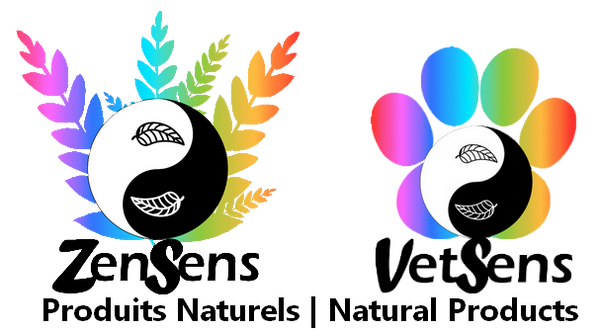Oh-oh, we're getting into chemistry class here! It's not my strong suit, I'll skip this section!
Wait! It's not that complex and it's essential (badum-tss!) for choosing the right oil for animals!
A chemotype (also seen under the names chemotypes and chemovars) is a way of categorizing plants according to their chemical composition within the same subspecies. They are also regularly called "major active principles" or "main constituents." This is what allows to differentiate, at the molecular level, a wild plant growing at high altitude from another of the same variety that has grown in a pot. In short, a plant that grows in a certain soil, in a certain place, and under certain conditions will not develop the same chemical properties as if it had grown elsewhere. A plant (or an essential oil) is made up of several chemical components (rosemary essential oil has 505!) that will influence its smell and effects.
One of the most well-known examples is thyme (Thymus vulgaris). This plant can grow almost anywhere, both in the wild and in flower beds and pots, in the suburbs and in the mountains, in Quebec or in China, in dry soil, moist soil, acidic soil... And all these factors change its composition!
Wild thyme growing in a harsher climate tends to produce an oil rich in geraniol, while the same thyme growing in arid regions will have a higher concentration of carvacrol.
There are several chemotypes ("ct") which are themselves classified according to their functional group. An essential oil will have a chemotype named after its major chemical component.
So, if you are looking for a thyme oil, you will come across several possibilities... Thymus vulgaris ct linalool, Thymus vulgaris ct thymol, Thymus vulgaris ct carvacrol, Thymus vulgaris ct gerinol, Thymus vulgaris ct thuyanol... Each of these oils will have a different smell and properties, so you need to know what to look for! However, not all oils have multiple chemotypes (Phew!).

The following table presents a summary of some chemical compositions of essential oils (chemotypes).
| Group | Common Properties | Main Constituents |
| Alkenes | Anti-inflammatory, Analgesic Antifungal, Antimicrobial, Anticancer |
Chamazulene Alpha-Pinene |
| Alcohols | Relatively non-toxic and low irritant Antiviral, Antifungal, Antiseptic Euphoric |
Linalool Santalol Citronellol Geraniol |
| Phenols see "Myths" | More acidic and reactive than average Considered "hot" oils, need dilution Powerful antibacterial and antifungal Immune support and stimulation Antiparasitic, Antitumoral |
Carvacrol Eugenol Thymol Chavicol |
| Aldehydes | Fruity odors Irritating to the skin, more prone to oxidation (thus worsens irritations) Antiseptic, Anti-inflammatory Immune support, Calming |
Cinnamaldehyde Geranial Citronellal Neral Citral |
| Ketones | Similar to aldehydes but more stable Generally excreted in urine as is (less metabolized) Some have neurotoxic properties that cause an excess of ketones to be transformed in urine Attention for renal/urinary function Aid digestion Reduce scar tissue Enhance tissue regeneration Anti-inflammatory, Relaxing and calming |
Camphor Carvone Menthone Thymoquinone Thujone |
| Carboxylic Acids | Oxidized aldehydes Low volatile, but highly reactive Uncommon in essential oils |
|
| Esters | Fruity and sweet Antispasmodic, Anti-inflammatory Calming and relaxing Antimicrobial |
Neryl Acetate Linalyl Acetate Methyl Salicylate |
| Ethers and Oxides | Contain more oxygen than Esters, therefore considered more potent Anti-inflammatory, antiseptic Diuretic and expectorant Help with nervous disorders |
Anethole Estragole Myristicine 1,8-Cineole |
| Lactones | Cyclic esters, heavier and less volatile Anti-inflammatory, Relaxing and Analgesic Antiviral, Antimicrobial and Insect Repellent |
Nepetalactone Coumarin |
| Furans (Furanocoumarins) | Citrus Photosensitizing compound |
Bergapten Angelicin Methoxsalen |
Why is it important to know the chemotype? Let's see essential oils as ingredients, and chemotypes as varieties.
For a pancake recipe, I need 2 cups of flour. If I want light pancakes, I will use sifted all-purpose flour, if I want denser pancakes, I will use whole wheat flour, if I have a guest with gluten intolerance, I will use brown rice flour...

So, if I want a thyme oil that is immune-stimulating and reduces fatigue, I will go for a "thyme ct linalool" rather than a "thyme ct thymol," which I would use for respiratory problems and coughs, and rather than a "thyme ct carvacrol" which has a higher toxic potential. It simply serves to choose the RIGHT ingredient to achieve the desired effect!
